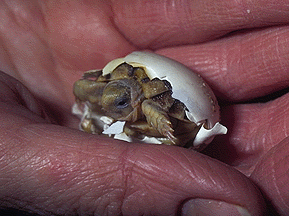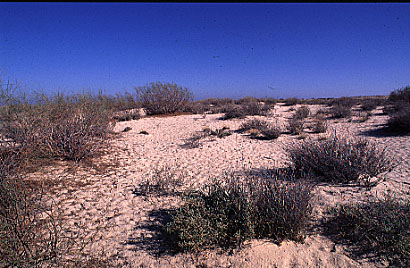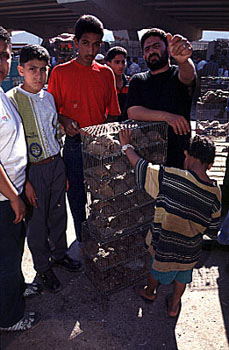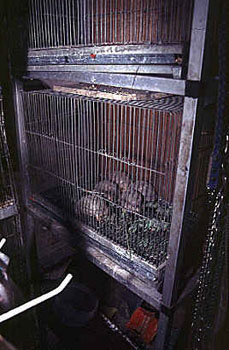
Species and Ecology
This is a desert animal, living under the most arid conditions tolerated by any tortoise species in the world. It is found in both sandy and fairly rocky habitats. The small size and the light coloration is an adaptation to the arid environment - the size allows a fast thermoregulation and the minimal black pigmentation minimizes heat absorption from the sun's rays. Color is considerably variable and appears to coincide with general soil color from the various regions where the animals come from. Thus, dark animals are thought to come from Gebel Akhdar in Libya, where vegetation cover is densest in the specie's range. Pinkish specimens are thought to come from areas of reddish soil in Cyrenaica.
The Egyptian Tortoise is a herbivore. Feeding on the leaves and flowers of the plants that survive in its harsh desert environment. The species is most active during warm times of year (February-April) and (September-October) and is inactive during months when the weather is very cold or very hot. During cooler months the tortoises are active in the middle of the day. In hot months, it is only active sporadically during the early morning and late afternoon, spending most of the day in the cover of bushes or in rodent burrows.
The Egyptian Tortoise is one of the world's smallest tortoises. The largest specimen ever described measured 128 mm, but most are smaller. Females are larger than males - most males are less than 90 mm.

The Egyptian Tortoise mates in early spring when the weather becomes warm. During mating, the male makes a purring sound and bumps the female from front and behind, while attempting to mount her. The females lay in spring up to five eggs (1-3 at a time), which she buries in a shallow depression in the sand under a bush or in a burrow. The eggs hatch in summer or early autumn. The baby tortoises are thought to remain largely inactive and feed little; taking shelter from the heat of the sun until the weather cools in autumn.
Range and distribution
Distribution of the Egyptian Tortoise
The desert habitats inhabited by the species in Egypt are under the influence of the Mediterranean Sea and have some of the highest precipitation in the country, as well as the coolest summer temperatures and coldest winter temperatures. Due to the relatively high moisture (compared with the desert interior) and unique climate, these desert regions gives rise to a rich plant and animal life and are considered to be a "Biodiversity Hotspot" in Egypt.
The Egyptian Tortoise is a species with a limited distribution confined to desert areas in northern Egypt, western Negev, Israel and northern Cyrenaica, Libya. It is a 'coastal' species, usually not occurring more than 90 kilometers from the coast.

Dotted Area Former Range - Solid Area Existing Range

Conservation Status
The Egyptian Tortoise is also protected by Egyptian legislation, both Law 53/1966 For Agriculture and Law 4/1994 for the Environment. According to the law, it is illegal to sell, purchase and transport this species without permits. Implementation of these regulations is still lagging.
The Egyptian Tortoise is considered one of the world's most endangered tortoises, populations in Libya are under heavy pressure from illegal collection for the pet trade. The tortoise is now virtually extinct in Egypt. The distribution in Israel is small, but those populations are reasonably well protected, although seem to have a precarious future. The Egyptian Tortoise is listed as "Endangered" by the 1996 IUCN Red List of Threatened Animals and under Appendix I of the CITES Convention, which prohibits trade in the species.
Threats
The main threats to the Egyptian Tortoise's long-term survival are (see more under Threats):
Conservation Efforts
In 1994 the IUCN Turtle Recovery Program, a joint effort of the Wildlife Conservation Society and the Tortoise and Freshwater Turtle Specialist Group of the IUCN Species Survival Commission commissioned a field study to assess the status of Egyptian Tortoise in Egypt. Sherif Baha El Din, a leading Egyptian herpetological expert, conducted the study. The findings determined that the Egyptian Tortoise had declined throughout its range in Egypt and was on the verge of extirpation from the country. This report confirmed that the Egyptian Tortoise is a globally endangered species and supported proposals that it be listed under Appendix I of the CITES Convention. The Egyptian government subsequently nominated the species to be upgraded from Appendix II to Appendix I of CITES, which was voted on and approved in November 1994 at a meeting of the parties to the convention. Since then, all trade in the species has been prohibited except for scientific purposes.


In Egypt there have been confiscations of Egyptian Tortoises by the Egyptian Environmental Affairs Agency and the police being sold at the Tunsi animal market (formerly held at Sayidi Aisha).
Abroad there have also been efforts to curb the illegal trade in Egyptian Tortoises. Two Egyptian sailors were arrested in northern England in 1998 selling Egyptian Tortoises on a street corner and were sentenced to four months in jail. One person has been fined in Sweden for selling illegal Egyptian Tortoises, and another investigation is under way, awaiting the prosecutor's final decision of bringing the matter before the court.
To consolidate and build upon these efforts, TortioseCare was established to promote the conservation of the Egyptian Tortoise and its habitats in Egypt and throughout its range (see project).
